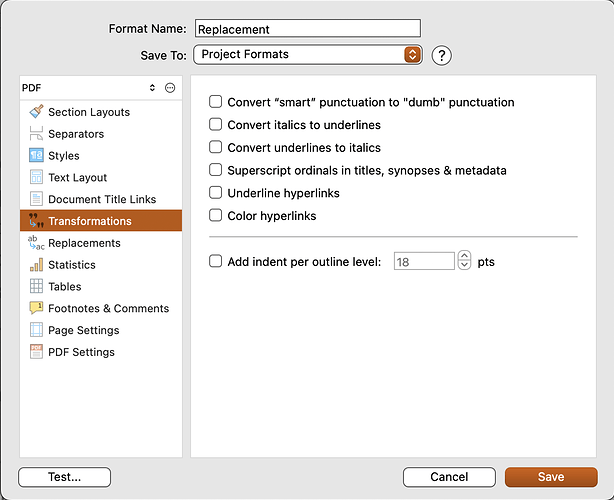@drmajorbob Thank you for confirming the information.
Concerning your remark about indentation, did you mean that it was easier to just uncheck it rather than set it to zero?
If that is the case, I have just done it, and you are right. I don’t know why I did not think of it before xD
Actually, I find that indenting the titles would be interesting, but I have looked everywhere and I cannot see how it is possible to indent JUST the titles without indenting the text.
@gr OK. Here is what I have done:
In Compile, I first went to “Styles” and added “Dylan Body” so that I could use it.
I then went to “Section Layouts” and in “Formatting”, “prefix” AND “suffix” *, applied “Dylan Body” to the whole text (except the Section Title, which I did not select)
- For your information, I do not have a suffix set at the moment, only a prefix, which is just a blank line, for which I have ticked “Place prefix after title” at the bottom so that I would always have a blank line between my titles/subtitles and the body of the text.
I am not sure I should apply “Dylan Body” to the section titles too.
Anyway, I have tested this. Not only does it not solve the issue, but I have some parts that were in “DylanBody” style and are now in “normal” style.
To make matters worse…
… the initial document I had tested it on was about 30 pages. Now I have tried compiling about 120 pages, including these. These behave in the same way, but in the preceding 30 pages, I have lots of parts that are not in the defined style.
I am now VERY worried. I downloaded Scrivener to write my PhD thesis and really need to get on with the writing, but since Scrivener does not integrate Zotero, I will HAVE to export it to .odt so that I can run an ODT scan with Zotero for citations and THEN convert it to docx.
I so much wish that Scrivener had Zotero integration, then I can could export directly to docx. Everything seems to work perfectly on .docx.
I have just tried it with the changes you advised for the sake of experiment. I have compiled 122 pages: I have not detected a single issue.
To answer your advise about not applying any style in Zotero in general, the reason I did it is that it figured that setting a style in the sections while working would allow me to know approximately what it would all look like at the end, in Times New Roman…
If you think I should just get rid of the styles, I could just probably try to work without “Dylan Body” and just define one style for the block quotes. Not ideal, but if necessary…
@kewms Since it compiles to docx and I can then convert to .odt, do you think that I should add another step to my workflow?
That would mean:
- compile to .docx
- save as .odt in Microsoft Word
- run an .odt scan with Zotero for citations
- export back as .docx
I suppose it could work. I just hope that, with all these conversions, it is not going to mess up my layout.
